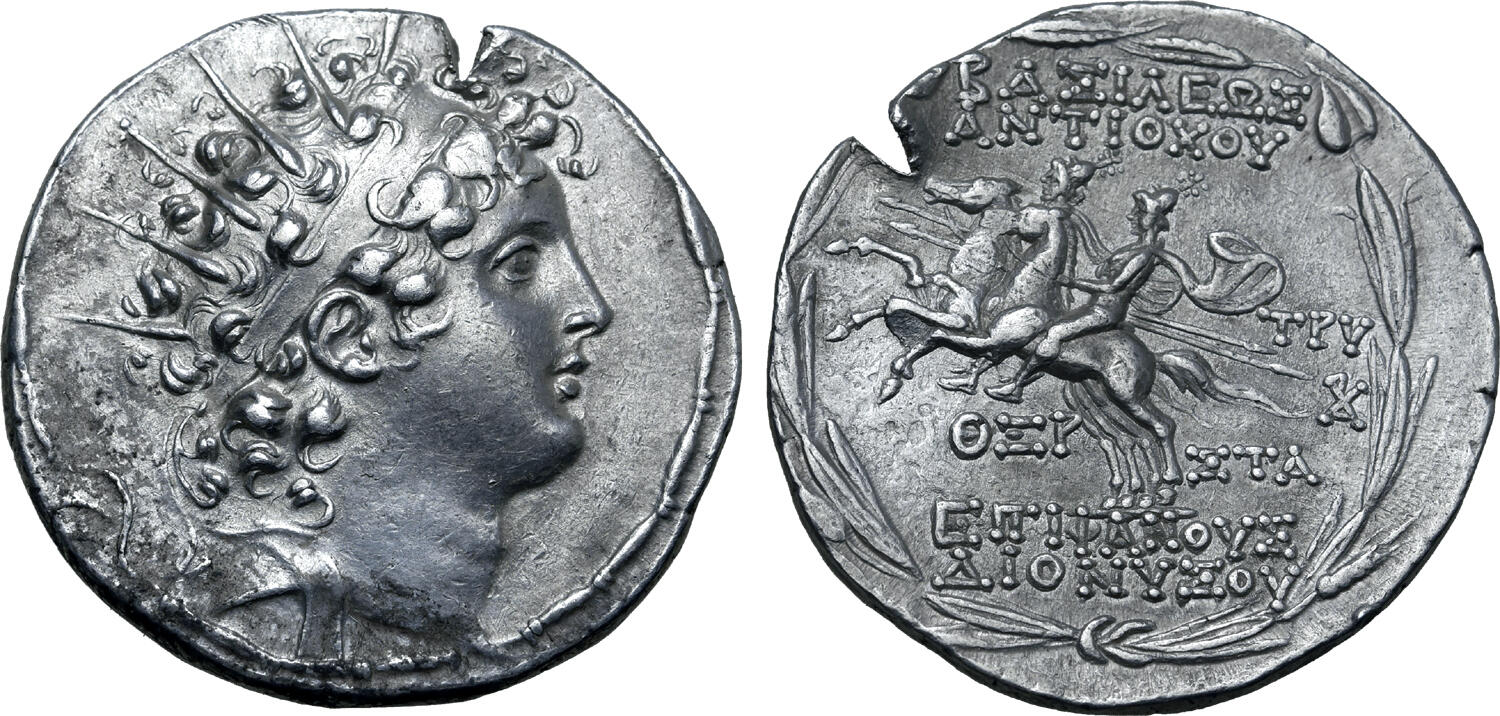Antioch (Antiochus VI), silver, tetradrachms (144-142 BCE)
From SILVER
144 BCE - 142 BCE Silver 9,222 kg
Description
| ObverseInscription or printing placed on the obverse.: | Radiate and diademed head to right |
| ReverseInscription or printing placed on the reverse.: | BAΣIΛEΩΣ ANTIOXOY EΠIΦANOYΣ ΔIONYΣOY (Greek).The Dioskouroi, holding reins in right hand and couched lances in left, on horses rearing to left, TPY above monogram above ΣTA to right, OΣP (date) to lower left, all within wreath of laurel, ivy, and grain ears |
Mint and issuing power
| MintIdentifies the place of manufacture or issue of a numismatic object.: | Antioch | Ancient regionAncient region.: | Syria | Modern countryModern country: Turkey | AuthorityIdentifies the issuing power. The authority can be "pretended" when the name or the portrait of X is on the coin but he/she was not the issuing power. It can also be "uncertain" when there is no mention of X on the coin but he/she was the issuing power according to the historical sources: | Antiochus VI Dionysus (Seleucid king, 144-142 BC), Seleucid Dynasty (312-63 BC) |
Chronology
| FromIdentifies the initial date in a range assigned in a numismatic context. | 144 BCE | toIdentifies the final date in a range assigned in a numismatic context.. | 142 BCE | PeriodTime period of the numismatic object.: Hellenistic 323-30 BC |
Physical description
| MetalThe physical material (usually metal) from which an object is made.: | Silver |
Median weightMedian of the weights of numismatic objects (in grams). in grams | 16.70 | DenominationTerm indicating the value of a numismatic object. Examples: tetradrachm, chalkous, denarius.: | tetradrachm |
StandardStandard.: | Attic |
Image

S2033 Antioch Antiochus VI.jpg [1]
References
| Die study referencePublication of the study: | Houghton 19911Houghton 1991, p. 90-91 (Table 5) | ||
| Coin series referenceReference to coin series study: | SC II2SC II, n° 2000, HGC 93HGC 9, n° 1032 | ||
Obverse dies distribution
| FrequencyFrequency of specimen in distribution. ᵖ | Number of obversesNumber of obverse dies. ᵖ (o) | % (o) | Number of coinsNumber of coins. (n) | % (n) | Die nameName(s) of the die(s). |
| 1 | 4 | 16 | 4 | 3.1 | 6, 11, 18, 19 |
| 2 | 5 | 20 | 10 | 7.75 | 1, 2, 7, 12, 23 |
| 3 | 3 | 12 | 9 | 6.98 | 3, 5, 17 |
| 4 | 2 | 8 | 8 | 6.2 | 13, 14 |
| 5 | 3 | 12 | 15 | 11.63 | 8, 16, 20 |
| 6 | 1 | 4 | 6 | 4.65 | 24 |
| 7 | 1 | 4 | 7 | 5.43 | 9 |
| 8 | 1 | 4 | 8 | 6.2 | 22 |
| 9 | 1 | 4 | 9 | 6.98 | 21 |
| 10 | 2 | 8 | 20 | 15.5 | 10, 15 |
| 15 | 1 | 4 | 15 | 11.63 | 4 |
| 18 | 1 | 4 | 18 | 13.95 | 25 |
| Total | 25 of 25 | 100 | 129 of 129 | 100 |
Reverse dies distribution
no distribution is available
Quantification
| Number of obversesNumber of obverse dies. ᵖ (o) | 25 | Number of singletons (o1)The number of singleton coins. ᵖ | 4 |
| Number of reverse diesNumber of reverse dies. (r) | Number of coinsNumber of coins. (n) | 129 | |
| Coins per obverse dieNumber of coins per obverse die. (n/o) | 5.16 | Coins per reverse dieNumber of coins per reverse die. (n/r) | |
| Reverse per obverse ratioRatio of obverse dies divided by reverse dies. (r/o) | Percentage of singletons (o1)number of coins (n) divided by the number of singletons (o1) ᵖ | 16 % | |
| Original number of dies (O) (Carter 1983 formula)The estimation of the number of coins according to Carter 1983 ᵖ | 27.61 | Coins struck if 20,000 as average productivity per dieCoins made if the average productivity for obverses (according to Carter) is 20,000. ᵖ | 552,200 |
| Original number of dies (O) (Esty 2011 formula)The estimation of the number of coins according to the singleton formula in Esty 2011 ᵖ (O) | 31.01 | Survival rate if 20,000 as average productivity per dieSurvival rate if average productivity is 20,000. ᵖ | 0.00023 |
| Coverage (o = % of O) (Esty 1984 formula)Esty 1984 - coverage (% of O) ᵖ (o = % of O) | 96.9% | Die productivity if survival rate 1/2,000Average productivity if survival rate is 1/2,000. ᵖ | 9,344.44 |
| Weight of silver (in kg) if 20,000 coins per die (O = Carter formula)Carter 1983 * Median weight * 20000 (*10 if gold or electrum) ᵖ | 9,222 kg <br /> 9,222 kg | Die productivity if survival rate 1/5,000Average productivity if survival rate is 1/5,000. ᵖ | 23,361.1 |
Remarks
Most likely more than 2 workstations